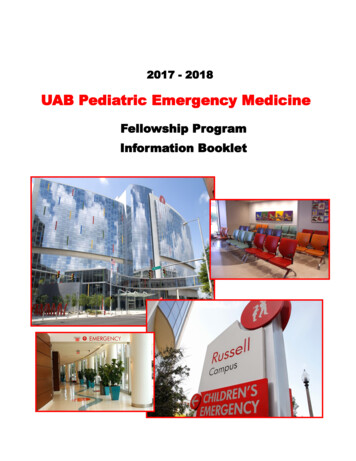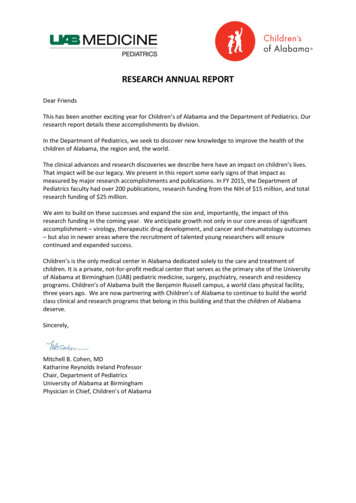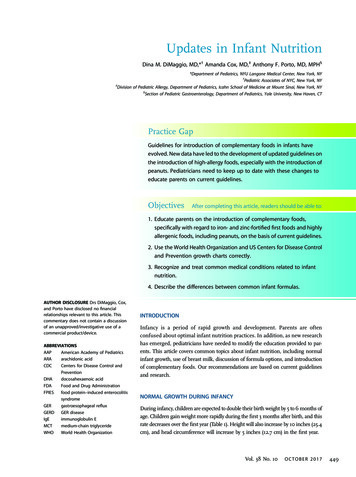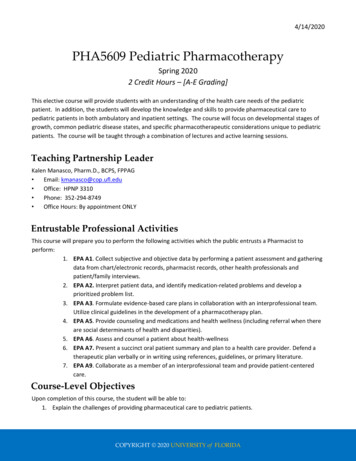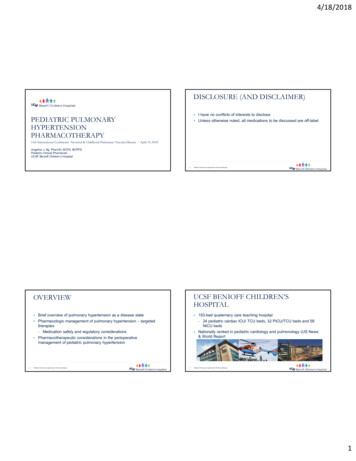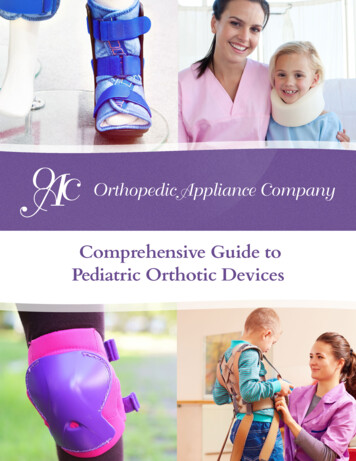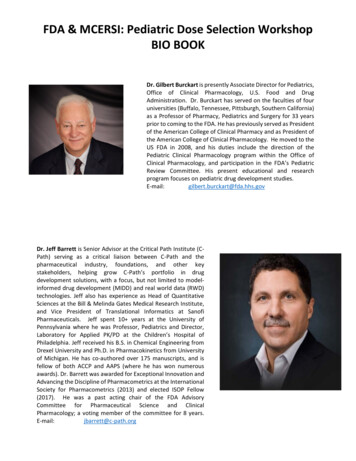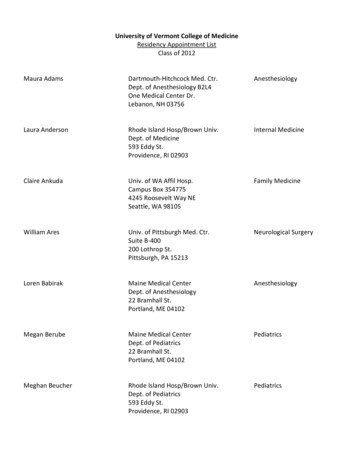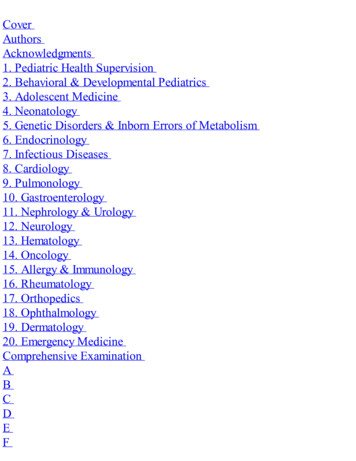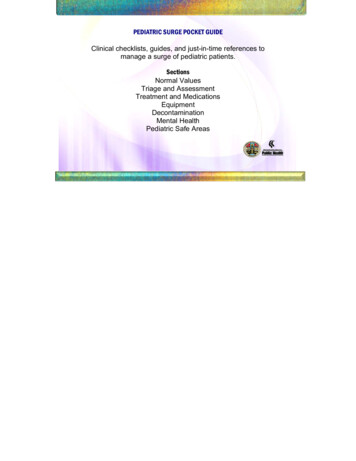
Transcription
Pediatric Emergency MedicinePractice Clinical Pathways:Evidence To Improve Patient CareIn Emergency MedicineBROUGHT TO YOU EXCLUSIVELY BY THE PUBLISHER OF:Emergency Medicine PracticePediatric Emergency Medicine PracticeEM Practice Guidelines UpdateThe Lifelong Learning and Self-Assessment Study GuideEM Critical CareED Overcrowding Solutions
Table Of ContentsAllergy/Endocrine EmergenciesClinical Pathway For Initial Evaluation Of Diabetic Ketoacidosis.1Clinical Pathway For Treatment Of Diabetic Ketoacidosis.2Clinical Pathway For Emergency Care Of Patients With A Metabolic Disorder.3Clinical Pathway For The Diagnosis Of Anaphylaxis.4Clinical Pathway For The Treatment Of Anaphylaxis.5General Emergency MedicineClinical Pathway: The Evaluation Of The Lower Extremity.6Clinical Pathway: Noninvasive Ventilation In Children.7Clinical Pathway: Management Of Dehydration In Pediatric Gastroenteritis.8Clinical Pathway: Management Of The Critically Ill Neonate.9Clinical Pathway: Pediatric Pain And Anxiety In The ED.10Clinical Pathway For The treatment Of Jaundice In 2- To 8-Week Old Infants. 11Infectious DiseaseClinical Pathway For The Treatment Of Enterovirus In The Neonate.122009-2010 Influenza Season Triage Algorithm For Children ( 18 years)With Influenza-Like Illness. 13-14Neurologic EmergenciesClinical Pathway For The Management Of Pediatric Seizures.15Clinical Pathway: Patient With ANC 500 Or Chemotherapy-Induced Neutropenia. 16Clinical Pathway: Patient With Mild To Moderate Neutropenia.17Clinical Pathway For Evaluation And Treatment Of Cerebral Edema.18Clinical Pathway: Migraine Headache Neuroimaging.19Clinical Pathway: Pediatric Migraine Clinical Treatment Pathway.20Toxicology And Environmental EmergenciesClinical Pathway: Oil Of Wintergreen, Pennyroyal Oil, Camphor, Eucalyptus,Imidazoline Decongestant.21Clinical Pathway: Diphenoxylate-Atropine.21Clinical Pathway: Organophosphates.22Clinical Pathway: Sulfonylureas.22TraumaClinical Pathway For The Treatment Of Pediatric Burns.23Clinical Pathway For The Treatment Of Mammalian Bites.24Clinical Pathway For Treatment Of Traumatic Dental Injuries.25Clinical Pathway For Treating Pediatric Wounds.26ii
Clinical Pathway For Initial Evaluation Of Diabetic Ketoacidosis Are results of history and physical examination consistent withdiabetic ketoacidosis (ie, polyuria, polydipsia, weight loss,fatigue, nausea/vomiting)?Does rapid glucose testing show elevated blood glucoselevel?Are ketones present in urine or blood?Initiate PediatricAdvanced LifeSupportAre there any airway,breathing, or circulationconcerns?YESNOInitiate evaluation for diabetic ketoacidosis. Establish a flow sheet. (Class III) Order the following laboratory tests (Class III): Serum glucose Arterial blood gas Electrolytes with anion gap calculation Calcium, magnesium, phosphorus Serum urea nitrogen/Creatinine Serum ketones Serum osmolality Complete blood cell count with differential cell count UrinalysisClassify diabetic ketoacidosis severity (Class II). Severe: pH 7.1 or bicarbonate 5 mmol/L Moderate: pH 7.1-7.2 or bicarbonate 5-10 mmol/L Mild: pH 7.2-7.3 and bicarbonate 10-15 15 mmol/L Administer 0.9%normal saline orlactated ringers 10mL/kg bolus over 1-2hours. (Class II)YESDoes the patientshow signs ofshock? NOFollow initial managementalgorithm (see ClinicalPathway For Treatmentof Diabetic KetoacidosisPathway)Class Of Evidence DefinitionsEach action in the clinical pathways section of Pediatric Emergency Medicine Practice receives a score based on the following definitions.Class I Always acceptable, safe Definitely useful Proven in both efficacy andeffectivenessLevel of Evidence: One or more large prospectivestudies are present (with rareexceptions) High-quality meta-analyses Study results consistently positive and compellingClass II Safe, acceptable Probably usefulLevel of Evidence: Generally higher levels ofevidence Non-randomized or retrospective studies: historic, cohort, orcase control studies Less robust RCTs Results consistently positiveClass III May be acceptable Possibly useful Considered optional or alternative treatmentsLevel of Evidence: Generally lower or intermediatelevels of evidence Case series, animal studies,consensus panels Occasionally positive resultsIndeterminate Continuing area of research No recommendations untilfurther researchLevel of Evidence: Evidence not available Higher studies in progress Results inconsistent, contradictory Results not compellingSignificantly modified from: TheEmergency Cardiovascular CareCommittees of the AmericanHeart Association and represen-tatives from the resuscitationcouncils of ILCOR: How to Develop Evidence-Based Guidelinesfor Emergency Cardiac Care:Quality of Evidence and Classesof Recommendations; also:Anonymous. Guidelines for cardiopulmonary resuscitation andemergency cardiac care. Emergency Cardiac Care Committeeand Subcommittees, AmericanHeart Association. Part IX. Ensuring effectiveness of communitywide emergency cardiac care.JAMA. 1992;268(16):2289-2295.This clinical pathway is intended to supplement, rather than substitute for, professional judgment and may be changed depending upon a patient’s individualneeds. Failure to comply with this pathway does not represent a breach of the standard of care.Copyright 2009 EB Practice, LLC. 1-800-249-5770. No part of this publication may be reproduced in any format without written consent of EB Practice, LLC.1Full issue available free for subscribers or for purchase for non-subscribers on our website.Full subscriptions are also available.We’d love your feedback on this iPad download — please share your comments andquestions in this survey.Return to the Table of Contents.
Clinical Pathway For Treatment Of Diabetic Ketoacidosis Determine the extent of dehydration.l Consider an estimate of 5%-7%dehydration as moderate and7%-10% dehydration as severe.(Class III) Calculate fluid requirement.l Consider 1.5-2.0 times maintenance plus deficit. (Class III)l Consider subtracting bolus(es)previously given for resuscitation.(Class III)l Calculate the rate of fluid replacement with a goal of replacinglosses over 36-48 hours. (Class II) Place patient on electrocardiogrammonitor. (Class II)Initiate 0.9% normal saline or LR atcalculated requirements. (Class II)Consider evaluation for voiding.(Class III)Recheck serum potassium level.(Class III)YESIs the patient’s serum potassium level 5.5 mmol/L?Class Of Evidence DefinitionsEach action in the clinical pathways section of Pediatric Emergency Medicine Practice receives ascore based on the following definitions.Class I Always acceptable, safe Definitely useful Proven in both efficacy and effectivenessLevel of Evidence: One or more large prospectivestudies are present (with rareexceptions) High-quality meta-analyses Study results consistently positiveand compellingClass II Safe, acceptable Probably usefulcontrol studies Less robust RCTs Results consistently positiveClass III May be acceptable Possibly useful Considered optional or alternativetreatmentsLevel of Evidence: Generally lower or intermediatelevels of evidence Case series, animal studies,consensus panels Occasionally positive resultsIndeterminate Continuing area of researchLevel of Evidence: No recommendations until further Generally higher levels of evidence research Non-randomized or retrospectivestudies: historic, cohort, or caseLevel of Evidence: Evidence not available Higher studies in progress Results inconsistent, contradictory Results not compellingSignificantly modified from: TheEmergency Cardiovascular CareCommittees of the American HeartAssociation and representativesfrom the resuscitation councils ofILCOR: How to Develop EvidenceBased Guidelines for EmergencyCardiac Care: Quality of Evidenceand Classes of Recommendations;also: Anonymous. Guidelines forcardiopulmonary resuscitationand emergency cardiac care.Emergency Cardiac Care Committee and Subcommittees, AmericanHeart Association. Part IX. Ensuringeffectiveness of community-wideemergency cardiac care. JAMA.1992;268(16):2289-2295.This clinical pathway is intended to supplement, rather than substitute for, professional judgment andmay be changed depending upon a patient’s individual needs. Failure to comply with this pathway doesnot represent a breach of the standard of care.Copyright 2009 EB Practice, LLC. 1-800-249-5770. No part of this publication may be reproduced inany format without written consent of EB Practice, LLC.2 NO Begin fluid replacement with 0.9% normal saline or LR plus 40 mEq/L of potassium chloride.(Class II)Consider alternatively starting with 0.9% normal saline or LR plus 20 mEq/L of potassiumchloride and 20 mEq/L of potassium phosphorus if phosphorus level is 1 mg/dL. Initiate insulin therapy.l Do not use bolus insulin. (Class II)l Use IV form of insulin. (Class I)l Start at 0.1 U/kg/h. (Class I) Regularly reassess the patient’s neurologicstatus. (Class II)Monitor laboratory values every 2-4 hours.(Class III)Add dextrose to fluid if blood glucose level hasdecreased to 250 mg/dL. (Class III)Consider cerebral edema evaluation and treatment if neurologic examination results change(see Clinical Pathway For Evaluation AndTreatment Of Cerebral Edema). (Class III)Consider decreasing the rate of insulin infusionif the patient’s blood glucose level decreasesby more than 50-75 mg/dL per hour. (Indeterminate)Consider decreasing the rate of insulin infusionif the patient’s serum osmolality decreases bymore than 3 mmol per hour. (Indeterminate)Full issue available free for subscribers or for purchase for non-subscribers on our website.Full subscriptions are also available.We’d love your feedback on this iPad download — please share your comments andquestions in this survey.Return to the Table of Contents.
Clinical Pathway For Emergency Care Of PatientsWith A Metabolic DisorderPerform ABCDEsA – Airway - Evaluate and protect airway as needed.B – Breathing - Ensure adequate ventilation Non-invasive ventilatory support may be considered where appropriate. Aggressive hyperventilation for cerebral edema should be avoided.C – Circulation - Volume expansion should be provided when there is evidence of dehydration or volume depletion.D – Disability - Bedside blood glucose testing: If below 60 mg/dL, obtain critical sample, IV access and provide glucose orally or via IV Low osmolarity glucose solutions (D5W, D10W) are preferred where available Critical sample: serum glucose, insulin, cortisol, and growth hormoneE – Exposure - Evaluate for exposure to infectious organisms, drugs, toxic substances, or new foodsConsider Additional Laboratory TestingPrimary: (most can be obtained with point of care testing devices) Arterial or venous blood gas Electrolytes Serum urea nitrogen and creatinine Urine dipstickSecondary: General – complete blood cell count with differential count Hypoglycemia – insulin, cortisol, corticotropin, b-hydroxybutryate Encephalopathy – ammonia, aspartate aminotransferase, alanine aminotransferase, bilirubin Suspected galactosemia – urine-reducing substancesTertiary: Quantitative plasma organic acids Quantitative urine organic acids Plasma acylcarnitine Tandem mass spectroscopy for disorders of fatty acid oxidation Amino acids in the blood, urine, and cerebrospinal fluid Orotic acid in the urine Comprehensive newborn screen with tandem mass spectroscopyTreatmentIf the child has a diagnosed metabolic disorder, follow instructions provided by their Metabolic specialist.Hydration – D10 1/2 NS at 1.5 times maintenance until needs for fluid, glucose, and electrolyte replacement have been determined.GlucoseMedications (as directed by Metabolic specialist, except as noted) Fatty acid oxidation disorders – L-carnitine Hyperammonenia – sodium phenylacetate, sodium benzoate, arginine Neonatal seizures – pyridoxine (may be given empirically with concurrent EEG monitoring as available) Organic acid defects – biotin 3Consider Consultations Or Referrals To:Critical CareGenetics/MetabolismNephrology– as indicated for renal replacement therapy for hyperammonemiaFull issue available free for subscribers or for purchase for non-subscribers on our website.Full subscriptions are also available.We’d love your feedback on this iPad download — please share your comments andquestions in this survey.Return to the Table of Contents.
Clinical Pathway For The Diagnosis Of AnaphylaxisDoes patient have acute onset of the following without a moreplausible explanation? Mucocutaneous signs (urticaria, generalized flushing,pruritis, angioedema)AND One of the following: Respiratory compromise (wheeze,stridor, hypoxemia, dyspnea) OR hypotension, collapse,syncope, incontinenceYESInitiate treatment for anaphylaxis.YESInitiate treatment for anaphylaxis.YESInitiate treatment for anaphylaxis.NODoes the patient have at least 2 of the following AFTER recentexposure to a likely allergen? Mucocutaneous signs (urticaria, generalized flushing,pruritis, angioedema) Respiratory compromise (wheeze, stridor, hypoxemia,dyspnea) Hypotension, collapse, syncope, incontinence Persistent gastrointestinal symptoms (vomiting, crampyabdominal pain)NODoes the patient have a known allergen AND hypotension* withinhours of exposure to that allergen?*or drop of at least 30% from baselineblood pressureNOConsider alternate diagnosesAdapted from Sampson HA, Munoz-Furlong A, Campbell RL, et al. Second symposium of the definition and management of anaphylaxis:Summary report—Second National Institute of Allergy and Infectious Disease/Food Allergy and Anaphylaxis Network symposium. J AllergyClin Immunol. 2006;117:391-397.4Full issue available free for subscribers or for purchase for non-subscribers on our website.Full subscriptions are also available.We’d love your feedback on this iPad download — please share your comments andquestions in this survey.Return to the Table of Contents.
Clinical Pathway For The Treatment Of AnaphylaxisYESIs patient in cardiopulmonary arrest?NOAdminister epinephrine 1:1000 (1 mg/mL)0.01 mg/kg to a maximum of 0.3-0.5 mg intramuscularly (Class II)PLUSOxygen and airway management as neededAre life-threatening symptoms of hypotension, respiratory distress, or stridor resolved?Initiate Pediatric Advanced Life Support or Advanced Cardiac Life Support YES NORepeat epinephrine every 3-5 minutes as necessary.Give fluid bolus as necessary.Consider inhaled B-agonists for persistent wheezing.If patient does not have risk factors for fatal or biphasicanaphylaxis, observe for 6 hours and discharge with anepinephrine auto-injector.YESAre symptoms resolved?Consider an H1 blocker for cutaneous symptoms(Class III)Consider an H2 blocker for cutaneous symptoms(Class III)Consider a corticosteroid to prevent biphasic reactions (Class Indeterminate)Consider admission to a monitored bed.NOConsider intravenous epinephrine boluses or an epinephrine drip for persistent hypotension.Admit to pediatric intensive care unit (PICU).Class Of Evidence DefinitionsEach action in the clinical pathways section of Pediatric Emergency Medicine Practice receives a score based on the following definitions.Class I Always acceptable, safe Definitely useful Proven in both efficacy andeffectivenessLevel of Evidence: One or more large prospectivestudies are present (with rareexceptions) High-quality meta-analyses Study results consistently positive and compellingClass II Safe, acceptable Probably usefulLevel of Evidence: Generally higher levels ofevidence Non-randomized or retrospective studies: historic, cohort, orcase control studies Less robust RCTs Results consistently positiveClass III May be acceptable Possibly useful Considered optional or alternative treatmentsLevel of Evidence: Generally lower or intermediatelevels of evidence Case series, animal studies,consensus panels Occasionally positive resultsIndeterminate Continuing area of research No recommendations untilfurther researchLevel of Evidence: Evidence not available Higher studies in progress Results inconsistent, contradictory Results not compellingSignificantly modified from: TheEmergency Cardiovascular CareCommittees of the AmericanHeart Association and represen-tatives from the resuscitationcouncils of ILCOR: How to Develop Evidence-Based Guidelinesfor Emergency Cardiac Care:Quality of Evidence and Classesof Recommendations; also:Anonymous. Guidelines for cardiopulmonary resuscitation andemergency cardiac care. Emergency Cardiac Care Committeeand Subcommittees, AmericanHeart Association. Part IX. Ensuring effectiveness of communitywide emergency cardiac care.JAMA. 1992;268(16):2289-2295.This clinical pathway is intended to supplement, rather than substitute for, professional judgment and may be changed depending upon a patient’s individualneeds. Failure to comply with this pathway does not represent a breach of the standard of care.Copyright 2010 EB Practice, LLC d.b.a. EB Medicine. 1-800-249-5770. No part of this publication may be reproduced in any format without written consent ofEB Practice, LLC d.b.a. EB Medicine.5Full issue available free for subscribers or for purchase for non-subscribers on our website.Full subscriptions are also available.We’d love your feedback on this iPad download — please share your comments andquestions in this survey.Return to the Table of Contents.
Clinical Pathway: The Evaluation Of The Lower ExtremityIs the patientstable?Perform a completehistory and physical.Does patient showsigns of trauma orsignificant mechanismof injury?YESYESIs a fracturepresent?Order appropriateimaging studies.(Class I)NONONOPerform PALS/ATLS and/or ABCs. Have the patientevaluated by a traumasurgeon. Transfer patient ifneeded. (Class I)Does the patienthave a functionaldeficit?Is the patient toxicappearing and/orlimping?NOExamine for Kocher predictorsand Luhman signs. Make a clinical judgment. (Class III)YESOrder anorthopedicconsult andfollowup.(Class I)YESYESIs the injury nonweight bearing?(Class II)NOClear patient for activity as tolerated. Follow up with PRN.(Class III)YESOrder laboratory studies:CBC, ESR, CRP, andfilms. (Class II)Is septic arthritislikely?YESNOOrder an emergent orthopedic consult. (Class I)NOIf signs andpredictors are notapparent, dischargepatient with followupin 24 hours.(Class III)If signs and predictors are apparent,admit patient forobservation andserial exams.(Class III)Are films abnormalor is SCFE or LCPpresent?Admit for observation.Consider pediatric andrheumatology consults.(Class II)NODo serial examinations showworsening symptoms?YESYESClass Of Evidence DefinitionsEach action in the clinical pathways section of Pediatric Emergency Medicine Practice receives a score based on the following definitions.Class I Always acceptable, safe Definitely useful Proven in both efficacy andeffectivenessClass of Evidence: One or more large prospectivestudies are present (with rareexceptions) High-quality meta-analyses Study results consistently positive and compellingClass II Safe, acceptable Probably useful Possibly useful Considered optional or alternative treatmentsClass of Evidence: Generally higher levels ofevidence Non-randomized or retrospective studies: historic, cohort, orcase control studies Less robust RCTs Results consistently positiveClass of Evidence: Generally lower or intermediatelevels of evidence Case series, animal studies,consensus panels Occasionally positive resultsClass III May be acceptableIndeterminate Continuing area of research No recommendations untilfurther researchClass of Evidence: Evidence not available Higher studies in progress Results inconsistent, contradictory Results not compellingSignificantly modified from: TheEmergency Cardiovascular CareCommittees of the AmericanHeart Association and representatives from the resuscitationcouncils of ILCOR: How to Develop Evidence-Based Guidelinesfor Emergency Cardiac Care:Quality of Evidence and Classesof Recommendations; also:Anonymous. Guidelines forcardiopulmonary resuscitationand emergency cardiac care.Emergency Cardiac Care Committee andSubcommittees, American HeartAssociation. Part IX. Ensuringeffectiveness of community-wideemergency cardiac care. JAMA.1992;268(16):2289-2295.This clinical pathway is intended to supplement, rather than substitute for, professional judgment and may be changed depending upon a patient’s individualneeds. Failure to comply with this pathway does not represent a breach of the standard of care.Copyright 2009 EB Practice, LLC. 1-800-249-5770. No part of this publication may be reproduced in any format without written consent of EB Practice, LLC.6Full issue available free for subscribers or for purchase for non-subscribers on our website.Full subscriptions are also available.We’d love your feedback on this iPad download — please share your comments andquestions in this survey.Return to the Table of Contents.
Clinical Pathway: Noninvasive Ventilation In ChildrenHemodynamic instability?Altered mental status?Excessive secretions or vomiting?Upper GI bleeding?Recent facial, upper airway, or upper GI surgery?YESIntubate.(Class I-II)NOExplain procedure to patient.Show patient the equipment and mask.Ensure patient is on monitor and pulse oximeter.Ensure adequate personnel to monitor patient.Apply mask to patient.CPAP: Start with low pressures (5 cm H20). Increase inincrements of 1 cm H2O.BiPAP: Start with low settings. IPAP of 8-10 cm H2Oand EPAP of 2-4 cm H2O. Titrate to effect.Typical IPAP levels in children are 8-16 cm H2O, andtypical EPAP levels are 4-8 cm H20.(Class Indeterminate)Positive response to therapy? Decreased respiratory rate? Decreased work of breathing? Improved oxygenation?NOWorsening agitation?Poor mask fit?Worsening hypoxia?Worsening respiratory distress?YESIntubate.(Class II)Continue noninvasive ventilation.(Class III)Class Of Evidence DefinitionsEach action in the clinical pathways section of Pediatric Emergency Medicine Practice receives a score based on the following definitions.Class I Always acceptable, safe Definitely useful Proven in both efficacy andeffectivenessClass of Evidence: One or more large prospectivestudies are present (with rareexceptions) High-quality meta-analyses Study results consistently positive and compellingClass II Safe, acceptable Probably usefulClass of Evidence: Generally higher levels ofevidence Non-randomized or retrospective studies: historic, cohort, orcase control studies Less robust RCTs Results consistently positiveClass III May be acceptable Possibly useful Considered optional or alternative treatmentsClass of Evidence: Generally lower or intermediatelevels of evidence Case series, animal studies,consensus panels Occasionally positive resultsIndeterminate Continuing area of research No recommendations untilfurther researchClass of Evidence: Evidence not available Higher studies in progress Results inconsistent, contradictory Results not compellingSignificantly modified from: TheEmergency Cardiovascular CareCommittees of the AmericanHeart Association and represen-tatives from the resuscitationcouncils of ILCOR: How to Develop Evidence-Based Guidelinesfor Emergency Cardiac Care:Quality of Evidence and Classesof Recommendations; also:Anonymous. Guidelines for cardiopulmonary resuscitation andemergency cardiac care. Emergency Cardiac Care Committeeand Subcommittees, AmericanHeart Association. Part IX. Ensuring effectiveness of communitywide emergency cardiac care.JAMA. 1992;268(16):2289-2295.This clinical pathway is intended to supplement, rather than substitute for, professional judgment and may be changed depending upon a patient’s individualneeds. Failure to comply with this pathway does not represent a breach of the standard of care.Copyright 2009 EB Practice, LLC. 1-800-249-5770. No part of this publication may be reproduced in any format without written consent of EB Practice, LLC.7Full issue available free for subscribers or for purchase for non-subscribers on our website.Full subscriptions are also available.We’d love your feedback on this iPad download — please share your comments andquestions in this survey.Return to the Table of Contents.
Clinical Pathway: Management Of Dehydration In Pediatric GastroenteritisWhat clinical signs of dehydration arepresent?NONEMILD/MODERATESEVEREStart ORT at 50-100 mL/kg, plus replace ongoing losses. (Class II)Admit patient.Use an oral antiemetic if vomiting ispresent and likely to impede ORT.(Class II)Give a 20 mL/kg bolus of normal saline;repeat until stable. (Class II)Is dehydration resolved?Is dehydration resolved?YESYESNOIf previous dehydration was noted, observe for a period of time in the ED.Admit to ward or observation unit.NOAdmit to PICU.Continue patient’s regular diet.Discharge home with hydrationinstructions and signs of dehydrationto look for.Abbreviations: ORT, oral rehydration therapy; ED, emergency department; PICU, pediatric intensivecare unitClass Of Evidence DefinitionsEach action in the clinical pathways section of Pediatric Emergency Medicine Practice receives a score based on the following definitions.Class I Always acceptable, safe Definitely useful Proven in both efficacy andeffectivenessLevel of Evidence: One or more large prospectivestudies are present (with rareexceptions) High-quality meta-analyses Study results consistently positive and compellingClass II Safe, acceptable Probably usefulLevel of Evidence: Generally higher levels ofevidence Non-randomized or retrospective studies: historic, cohort, orcase control studies Less robust RCTs Results consistently positiveClass III May be acceptable Possibly useful Considered optional or alternative treatmentsLevel of Evidence: Generally lower or intermediatelevels of evidence Case series, animal studies,consensus panels Occasionally positive resultsIndeterminate Continuing area of research No recommendations untilfurther researchLevel of Evidence: Evidence not available Higher studies in progress Results inconsistent, contradictory Results not compellingSignificantly modified from: TheEmergency Cardiovascular CareCommittees of the AmericanHeart Association and represen-tatives from the resuscitationcouncils of ILCOR: How to Develop Evidence-Based Guidelinesfor Emergency Cardiac Care:Quality of Evidence and Classesof Recommendations; also:Anonymous. Guidelines for cardiopulmonary resuscitation andemergency cardiac care. Emergency Cardiac Care Committeeand Subcommittees, AmericanHeart Association. Part IX. Ensuring effectiveness of communitywide emergency cardiac care.JAMA. 1992;268(16):2289-2295.This clinical pathway is intended to supplement, rather than substitute for, professional judgment and may be changed depending upon a patient’s individualneeds. Failure to comply with this pathway does not represent a breach of the standard of care.Copyright 2010 EB Practice, LLC d.b.a. EB Medicine. 1-800-249-5770. No part of this publication may be reproduced in any format without written consent ofEB Practice, LLC d.b.a. EB Medicine.8Full issue available free for subscribers or for purchase for non-subscribers on our website.Full subscriptions are also available.We’d love your feedback on this iPad download — please share your comments andquestions in this survey.Return to the Table of Contents.
Clinical Pathway: Management Of The Critically Ill NeonateDoes the neonate require emergentresuscitation?NOPerform history and physicalexamination; checklaboratory test andradiograph results;conductfurther testing asneeded.Start PGE1 at 0.05µg/kg/m
Pediatric Emergency Medicine Practice Clinical Pathways: Evidence To Improve Patient Care In Emergency Medicine BROUGHT TO YOU EXCLUSIVELY BY THE PUBLISHER OF: Emergency Medicine Practice Pediatric Emergency Medicine Practice EM Practice Guidelines Upd
